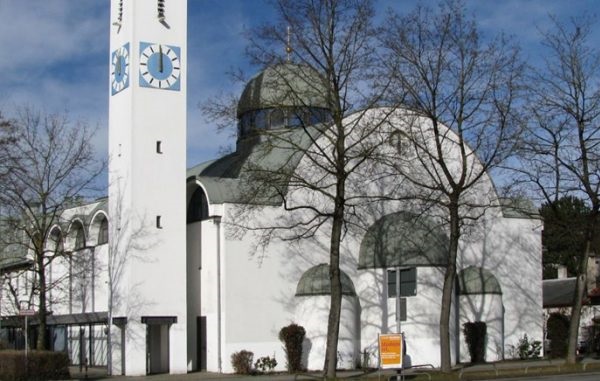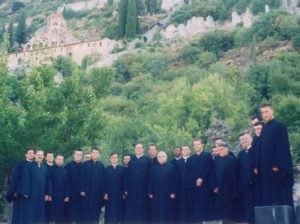Christianity in the Contemporary World: In Search of New Perspectives of a Dialogue of Religions
9 July 20181.
At the turn of the 19th century, German poet and mystical philosopher Novalis wrote his famous essay Christendom or Europe. Already the title of it was stating clearly the identity of the two historical phenomena; and though Novalis described the process through which Europe was gradually losing “the beautiful chief characteristics of these truly Christian times,” he was convinced that the original identity could not be lost. Europe and the Western World, could be Christianity, better or worse, but they could not be anything else at their core, since there is not (and there cannot be) another ultimate meaning of their historical existence. “Ultimate meaning cannot be annihilated, it can be just clouded, weakened, superseded by other meanings.”[1] And we can assume that, with some limitations, this position was then shared by most of enlightened Europeans; it was a voice of European self-consciousness.
Two centuries later, at the turn of the 21st, European self-consciousness expressed a polar opposite position: after fundamental discussions, a very representative forum consisting of participants from all the countries of the continent, refused to include any reference – not only about ultimate meaning, but also about virtual Christian ancestry of European culture – into The European Union’s Constitution. In a sense, that refusal is a symbolic event marking the apex of secularization, a break with Christian consciousness when the “gathered powers,” essentially, agreed to replace Novalis’ expression with the opposite: Postchristianity or Europe.

This striking shift is a fruit of the history of the 20th century which was ultimately dramatic for Christianity. A variety of factors led to the intensification and acceleration of social secularization, as well as the start of the post-Christian phase in countries of Christendom.
The experience of world wars and totalitarianism showed the fragility of, and in some measure, the ostensibility of, Christian principles of conscience and society; it revealed a deep crisis of Christian ethics that could not interdict Christian peoples – neither in Orthodox Christian Russia, nor in Lutheran Germany – from mass support for inhuman totalitarian regimes.
Then came an explosive development of technological civilization that was accepted by mass consciousness as ‘the highest stage of development,’ which made the religious form of consciousness obsolete, inadequate to the new reality as well as to new possibilities for man and his mind. Finally, the advent of globalization brought an intense mixing of ethnicities and cultures, as well as of communities with different religions, and entailed an ultimate dilution of traditional order and replacement of monoreligious societies. Hardly anywhere now, do Christian communities form monolithic “Christian societies,’ instead they find themselves in an extremely heterogeneous medium, closely neighboring with representatives of other religions, and people with secular, non-religious consciousness. Now, at this stage, the idea that the contemporary West is ‘postchristianity’ has acquired popularity. This notion has never been clearly defined, being generally used in accordance with its literal meaning: as a denotation of a new formation of society and consciousness, for which Christianity is irremeably, irreversibly in the past. But it is important to note that the concept of postchristianity had not yet fully formed and reached universal dominance, when another concept, another perspective on the contemporary situation started to force it out and supersede it.
This new idea which is acquiring more and more influence nowadays is that of postsecularism, first suggested by Jьrgen Habermas in the aftermath of the terrorist attack of 9/11 (though the term itself had emerged before without becoming a full-fledged concept). The idea affirms that nowadays secular (extra- or non-religious) and religious consciousness form a new type of interrelationships, quintessentially different from their relationships in the epoch of secularization. The determining trait of this type of relationship is its rejection of secularization’s leading strategy, which was directed toward the displacement and elimination of religion from social and culture life, and supposed that such elimination would become total or nearly total in the near future. (Hence we can see that the idea of postchristianity can be considered a kind of flash-forward to a time when complete secularization is believed to be an accomplished fact.)
Two basic suggestions supersede this strategy. First, religious consciousness is not admitted as a backward and obsolescent formation – a kind of ‘vanishing scenery’ – but as an everlasting, immanent factor of human existence. Second, and equally important, it is assumed that secular consciousness and religious consciousness should be neither isolated from each other nor in confrontation with each other, but that they should develop an active contact and mutually tolerant communication, and build a dialogue targeted at mutual understanding.
At the moment these ideas are being actively discussed. They generally find support in both secular and religious circles. A meeting and discussion between Jьrgen Habermas and Cardinal Joseph Ratzinger (now Pope Benedict XVI) held in Munich on January 19th 2004 can be considered as the specific starting point, a symbolic meeting of two sides of the postsecular dialogue. Old confrontation attitudes certainly do not disappear easily. Radical secularization was part and parcel of Western liberalism’s positions for a long time, while the condemnation of non-religious consciousness, as well as an uncompromising attitude to it were a necessary feature of orthodoxal religious (but not only fundamentalistic) views. As current events in Russia and the whole Christendom brightly demonstrate, conflicts between adherents of those opposite views still take place at all levels, and are still a characteristic trait of modern life. However, the weight of evidence suggests that the foundation for a transition to a postsecular formation has been laid. Its development is gradually becoming one of leading trends in social and anthropological reality.
[1] Novalis. Die Christenheit oder Europa. Ein Fragment // Id. Dichtungen und Prosa. Verlag Philipp Reclam jun. Leipzig, 1975. S.446.
Relations between Christianity and (secular) society are doubtlessly the main constituting factor of Christianity’s situation in the contemporary world. However, there are two more important constituting factors to the situation: internal interconfessional relationships inside Christianity and the relationships between Christianity and other religions. Relationships of different parts of Christendom, its different confessions and types, played a key role on stage of History for a long time. Those relationships used to be typically marked with mutual prejudice, confrontation and conflicts, and with frequent violence. The fight against heresies during the first Christian centuries and Middle Ages, conflicts between Catholics and Protestants during the Reformation, the history of the Inquisition in the West, the history of schism and sectarianism in Russia, left a number of examples of wars, bloodshed and cruel repressions. Then the modern era brought certain mitigation, humanization of customs; blatant manifestations of violence and cruelty decreased (though works of contemporary historians, like M. Foucault and others, demonstrate that violence and cruelty still persist even in ‘enlightened societies’ towards various marginal minorities – the mentally ill, homosexuals, prisoners). However, they are succeeded by moderate forms of hostility – tension and alienation, mutual distrust and disapproval, heavy burden of accumulated recriminations, prejudices and superstitions. An attitude towards a non-orthodox Alien in Christian consciousness still showed rejection and intolerance, though they had not expressed in direct aggression yet.

At the same time Christian consciousness could not forget that a call to unity of all Christians and fraternal affection among them is a part of grounds of Christ’s Gospel. Efforts to reach this unity did not cease during all historical periods, taking various shapes. Initially these were attempts of a formal junction: top-down unifications of church leadership, driven by some external, non-spiritual, motives or circumstances; and not resulting, as a rule, in real spiritual unity. But in the area of interconfessional contacts, some other endeavours and models gradually started to be undertaken. In the first half of the 20th century the Ecumenical Movement became a mainstream of such contacts. It emerged in the circles of American Protestantism and cultivated various forms of rapprochement and unity, mostly between Protestants and Orthodox Christians. (Catholic Church rejected participation in this movement ad initium.) Its activities were not fruitless in many respects. It gave a valuable support to the impoverished Russian Emigration’s many clerical and cultural enterprises to mention the contributions to Russian spiritual culture made by the St. Sergius Orthodox Theological Institute, the Journal Put’, and the YMCA-Press in Paris in the 1920’s and 1930’s. It also developed a wide range of arrangements and institutions to fulfill interconfessional contacts and to put them into a regular form. The main institution of such a kind, the World Council of Churches, established in 1948, was able to become both organizational and ideologic, intellectual center of Christian unity owing to participation of major religious thinkers such as Orthodox Christian theologian P. Georges Florovsky and Protestants Karl Barth, Emil Brunner and Anders Nygren. Activities of the Ecumenical Movement, quite active participation of Russian Orthodox Church in interconfessional contacts as well as renewal and changes in the Catholic Church after the Second Vatican Council of 1962-65, resulted in notable strengthening of intra-Christian communication, in mitigation of centuries-long intransigence and enmity. In 1965, the Catholic Church and the Ecumenical Patriarchate of Constantinople mutually lifted the anathemas between them. “One of characteristic events in contemporary Christianity is dilution of confessional discord,”- Sergei Averintsev wrote[2]. To a great extent this dilution of discord is the result of development of interconfessional dialogue. It is within the realm of possibility that the accumulated vast experience of such a Christian dialogue to some extent can be transferred to the field of an interreligious dialogue.
2.
Relations with other religions are the last remaining factor in the Christian situation. It has a special significance for our theme, so we will consider it more systematically. What common principles define the Christianity’s stance toward other religions? It goes without saying that all the cornerstones of this stance can be found in the New Testament. Christ is The Way, The Truth and The Life: The Truth, personally embodied in all its entirety; without Christ, without union with Him, there is no Salvation of man – no possibility of achieving man’s full self-actualization, his life purpose. But this absolute directive of Christianity does not impose an unambiguous attitude toward other religions; it leaves open the possibility of two opposite positions, which are usually referred to as the principle of exclusiveness and the principle of inclusiveness. Without going into the details of other religions and beliefs, we can see that, a priori, they can be in one of two positions vis-а-vis Christianity (in which lies for us the entirety of truth): their grounds and credos can either have nothing in common with Christian ones, being utterly alien and opposed to them; or else they can bear within themselves some primary and inchoate forms, some vague forestalling, partial reflexions, and elements, of the Christian Truth. In the second case, it could be suggested that the spiritual essence of those other religions has been, to a certain extent, absorbed, included into Christianity; finding within Christianity a fulfillment and endorsement, an actualization of its own potencies. This outlook on other religions is the attitude of inclusiveness; while the opposite attitude, which denies other religions any measure of truth and commonality with Christianity, is that of exclusiveness.
In its concrete history Christianity did not make a thetic choice between these two attitudes; neither one nor the other was rejected essentially. Even in the Early Christian epoch, when the uniqueness of God’s Incarnation in the image of a slave was especially fervently perceived by the new Christians, who were experiencing the unprecedented new reality opened by this event – Christ had told them himself that he had come not to abolish the Law but to fulfill it; and Apostle Paul, speaking about the Hellenes’ religion, told the men of the Athenian Areopagus that, in worshiping The Unknown God they, unknowingly, worshiped Christ. In other words, even when the attitudes of exclusiveness were the most natural and clear, teachers of Christianity also pointed to the presence of inclusiveness in the new belief, too.
[2] S.S. Averintsev. Christianity // New Philosophy Encyclopedia. Vol. 4. Moscow, 2001. P. 306. С.С.Аверинцев. Христианство // Новая Философская энциклопедия. Т.4. М., 2001. С.306.
Later, the both attitudes followed a difficult path. If we describe it very simple, we can say that up to The New Age the attitude of exclusiveness detaching Christianity from the entire universum of the world religions and beliefs, had been much more noticeable and predominant.
This attitude was much closer to mass Christian consciousness, while that of inclusiveness manifested more as a tendency in the teachings of a small number of thinkers who were inclined toward resumptive and rationalist views of the reality (for example, Nicholas of Cusa). However in Contemporary Era the position of inclusiveness is gaining more and more currency. In academic theological thought, this was facilitated by the development of the disciplines of historical criticism and comparative religious studies; and, in the broader social consciousness, it was facilitated by the active processes of ethno-cultural migrations and mixings. In contemporary Western theology there emerged noteworthy teachings affirming inclusiveness principle – first and foremost, teachings of Karl Rahner (1904-1984) and Joseph Ratzinger, now Pope Benedict XVI. Ratzinger summarizes the modern concept of inclusiveness as following: if, according to Rahner, “all religions are moving to Christianity, unaware of their movement,” then Ratzinger himself discovers the sense of that movement: “All the cultures are permeated by understanding of human striving for God <…> of conviction, repentance and absolution, conscious oneness with God <…> and finally acceptance the basic moral canons as they are formulated in Decalog,” so ad extremum, “inclusiveness reflects the essence of history of human cultures and beliefs.”[3]
At the same time, as Ratzinger also notes, the extreme expressions of inclusiveness, strongly accenting the commonality and likeness of Christianity to all other religions, lapses into pluralism – a position, close to Eastern mysticism, by which all religious teachings, despite their outward diversity, are tried against one and the same spiritual essence. That attraction to pluralism, also fed with multiculturalism ideology, is one of the trends of present-day dilution of Christianity which is a process, noticeable enough within Protestantism. In the afterlight of the fact that “pluralism and inclusiveness sporadically are about to verge into each other,”[4] the inclusiveness principle must be accepted within bounds only. On the other hand, exclusiveness principle also cannot be entirely displaced and discarded. In its emotional and existential aspects, Christian religiosity (though to different extents: stronger in Orthodoxy than in Protestantism is inseparable from the feeling of “The Narrow Path” – of an intense experience of communion with Christ as the “one thing which is needful;” as the only saving thread which, by definition, is nowhere besides Christianity. Professors can find in Christianity as much in common with a number of other religions as they want, but I know, with my whole soul, that my way of striving for Christ and union with Him is narrow, sole, and none of other ways, whatever close, neighboring to Him they would seem, do not lead to Him.
In sum, we can describe the contemporary Christian position on religiosity with respect to other religions as an acknowledgment of Christianity’s essential inclusiveness in terms of ideals, history and culture; combined with elements of exclusiveness on the level of ‘Religious Feeling,’ the level of personal emotional-existential aspects of faith.
Now it is time to say, that notions of inclusiveness and exclusiveness which at first glance seem to be abstract and theoretic, actually are directly associated with practice of inter-religious relations. Evidently, inclusiveness tends to suggest an open and benignant attitude toward other religions, so long as they are at least somewhat ‘pregnant with Christianity;’ that is, so long as they bear some rudiments, some potencies of the Truth, which in Christianity is fully given and revealed. An as example, we can call to mind the overtly inclusive conception of ‘potential Orthodoxy,’ advanced by Eurasianist circles in Russian emigration: supporters of the concept worked toward convergence with the adepts of non-Christian religions, claiming that those religions (which did not know the Christian sermon) were ‘potentially’ close to Orthodoxy – in contrast to, for example, the Catholics, who had deliberately detached themselves from Orthodoxy. Inclusiveness position encourages a dialogue of religions; theses on some or other specific ‘grains of Christianity’ in other religions could become an initial base of the dialogue.
Such dialogue, however, requires maximal tact on the Christian side, since the representation of another religion as simply a primitive form of Christianity, which had not completely fulfilled its potential, may naturally evoke protest and dismissal in the dialogue’s partners.
The attitude of exclusiveness seems on first glance to urge us, on the contrary, toward alienation and isolation from other religions; on closer examination however, this turns out to be far from the case. At the very essence of Christianity is its pan-human and universal character, a craving for a dispensation where ‘there is neither Hellene nor Jew.’ Athonian monks are demonstratively a striking example of the most ardent, the most ‘exclusive’ faith. But the Elder Silouan, a great Athonite hermit of the 20th century, made a prayer for everyone, for all Christians and non-Christians, the very center of his spiritual practice, and his spirituality was called mystic of love to brother: not only to a Christian brother, but to every fellow creature. And similar to the ascetic life of monks-hermits in ancientry, today Rev. Silouan’s ministry influences the whole Orthodox Christian world, appealing to expand the circle of Christian love to everyone, beyond Christianity.
[3] Joseph (Benedict XVI) Ratzinger. Faith – Truth – Tolerancy. Christian Belief and World Religions. Moscow, 2007. Йозеф (Бенедикт XVI) Ратцингер. Вера – истина – толерантность. Христианство и мировые религии. М., 2007.
[4] Ibid. P. 92 Там же. С.92.
Further, there is another important sphere related to Christianity’s universalism, which brings Christianity – even in the position of exclusivity – to contact with other religions. This sphere is the mission to preach the Christian sermon all over the world which, already in the New Testament, is asserted as a Christian duty. Its fate nowadays is not easy. Diverse forms and methods of missionary work have been practiced for ages; including the harshly straightforward methods that combined with pressure of secular authorities, according to the ancient principle cujus regio, ejus religi. In subduing colonies and conquering new lands and tribes, such methods were the norm. These days they have almost disappeared, but they have left persistent historical memory, because in many circles and countries they created an attitude toward missionary work like toward expansion and pressure of Christianity. In this area too, there are some new developments, take for example the officious and primitive propaganda of some recently emerged Protestant sects, which reduce the Christian teaching to its absolute limit. The contribution of such phenomena to inter-religious contact can be hardly considered to be positive. However, the mission is an irrevocable Christian duty, which means that nowadays it must find new forms, adequate to evolving inter-religious relations. These new forms – and ancient at the same time – must take us back to the clear original sense of the Christian mission.
It should open the Truth of Christianity to people; as long as we believe that Christ is the Truth, we must absolutely help our neighbor to discover the Truth! Missionary work comes close, if you will, to Socrates’ art of maieutics. So an experienced contemporary Orthodox Christian preacher writes: a missionary must “help his listener dislodge the tares from their souls and preserve wheat <…> Warmth, love, affection toward people <…> this is the most important quality for a missionary.”[5]
Contemporary situation of inter-religious relations in the world is complicated and ambiguous; it is saturated with controversial trends and factors. On one hand, analogous to the slackening of inter-confessional strife within Christianity, there emerges an understanding between various very different religious groups of the communality of their interests; as they are all equally caught in the powerful wave of secularization and globalization, which pushes-aside and marginalizes religion per se, religious consciousness in any of its instantiations. Today almost all religions encounter similar difficulties of existing in a deeply secularized society and state – but the rallying effect of this common secular threat is still relatively insignificant. To a notably greater extent, the contemporary situation is characterized by an escalation of all the possible religiously-driven conflicts. All traditional trouble spots of inter-religious (and inter-ethnic) tension are extremely active. As we have mentioned above, globalization processes generate major incessant migrations, so, beside old areas of close inter-religious contacts and mixing, many new ones arise. Active inter-religious contacts become inevitable, virtually for all religious communities.
In such circumstances, it is vitally important to develop efficient strategies of solving inter-religious conflicts, to find new ways and methods of defusing inter-religious tensions, and to establish stable regimes in which various religions harmonically coexist in the same space. With no alternative, the main and key element of such strategies can be only a dialogue between religions. In conclusion we will consider the question how this dialogue is understood in Christianity and we will discuss its development perspectives in contemporary situation.
3.
Religious dialogue, as a concept and a problem, was first studied systematically by Paul Tillich (1886-1965), one of the most influential Protestant theologians. Generalizing his vast experience of observation of inter-religious contacts, in 1962 he published the first contemporary monograph on this problem: Christianity and the Encounter of the World Religions. There he formulated a body of principles of inter-religious contact, which became the well-known and influential Tillich’s Platform. Here are the principles.
“The dialogue between exponents of different religions is based on a number of postulates. First, it is supposed that both partners recognize the value of religious standings of the other side… so that both of them agree on the importance of the dialogue. Secondly, it is supposed that each partner is capable to uphold his religious views with due competence so that the dialogue represents a serious comparison of opinions. Thirdly, it is supposed that a certain common ground is present, on which both dialogue and confrontation are possible. Fourthly, both sides are supposed to be open to criticism of their religious foundations. If all these conditions are met, <…> such encounter of two or several religions might be very fruitful and if the dialogue goes on, it might even bring forth historical consequences.”[6]
[5] Archpriest Artemii Vladimirov. On Holistic Christian Worldview and on What an Orthodox Christian Missionary Should Be // Contemporary Ortrhodox Christian Mission. Ekaterinburg, 2010. P. 62, 73. Прот. Артемий Владимиров. О целостности христианского миросозерцания и о том, каким должен быть православный миссионер // Современная православная миссия. Екатеринбург, 2010. С.62, 73.
[6] P. Tillich Christianity and the Encounter of the World Religions. П.Тиллих. Христианство и встреча мировых религий // Он же. Теология культуры. М., 1995. С.425.
In the last several decades, the dialogue between religions has grown into an extensive sphere of life in the international community. Functioning mechanisms and institutions, like the Council for a Parliament of the World’s Religions, have managed to be constructed, establishing regular frames for the dialogue and giving it a permanent character. A number of major meetings were held with their help, in many cases quite literally facilitating the resolution, or prevention, of religious conflicts. In the ensuing sections of this monograph, these specific institutions and events will be examined in detail. Now we should say that at present there still are enough principal difficulties and problems in the area of inter-religious dialogue, notably the contemporary situation adds some new problems to the pre-existing ones.
It is possible to notice a feature which demonstrates limitation of the success the dialogue has reached so far. As a rule, this success lay in various official agreements which were implemented as actions of some or other official organizations. In other words, the dialogue was completely regimented and formalized, and it remained a dialogue of structures, institutions, and leaders. Therefore, in spite of its success it changed very little, or nothing at all, about the overall atmosphere of inter-religious relations, which formed in the situations and attitudes below, at the grass-roots level, in the thick of the religious communities themselves. The dialogue dramatically lacked a personal dimension; lacked live human interaction, whose course changes mutual feelings and attitudes of people and communities. Now it is reasonably safe to say: the future of the dialogue of religions depends on our ability or inability to fill it up with those dimensions.
In my Dialogue of Religions: Historical Experience and Fundamental Grounds, written as part of our department’s previous project, I describe the design of two models of religious dialogue. According to this design, formalized and regimented dialogue can lead only to finding a ‘common denominator,’ a sum of all the positions shared by the participating sides. Such revelation of the grounds for consensus can help reconcile cases of conflict, but it principally excludes from the dialogue all diversity, all of its participants’ specific differences; excluding thereby the individual depth of their worlds and all the elements of their actual religious lives.
The fruits of such dialogue do not penetrate to the grass roots level, and do not leave significant after-affects. However beside this model of inter-religious dialogue, there is another model, based on another communication type. An institutionalized dialogue uses the formalized communication of structures, what in computer terms is known as communications protocol. The alternative model, on the other hand, is based on personal comminion, which has radically different qualities of communication: here, among other things, the space of the dialogue is much more extensive, and includes the sides’ individual characteristics, allowing therefore a much fuller self-expression. The engagement of such model could therefore produce valuable effects, although its practical feasibility is not evident: obviously, inter-religious dialogue is not the same as a dialogue between individuals. But this difficulty happens to be surpassable. One can note at least two ways for inter-religious dialogue to engage the powerful resources of personal human interaction.
One of these ways is well-known, and is frequently used in ecumenical interconfessional contacts between Christians. I am referring to various kinds of informal collective interaction – interaction of the most diverse groups, who emerge most often from below and enter, spontaneously and by their own initiative, into inter-confessional contact, of an informal, once again, character. Because of the key condition of informality, communication during such contacts (although they are collective) can remain essentially personal, without turning into the formalized communications protocol. Such contacts are primarily fed by genuine interest toward the other side’s personal experience and outlook; and in recent years, they have reached such a scale as to visibly affect the global situation, the global atmosphere of interconfessional relations. Suffice it to only note the example of the Taizй (France) meetings, which annually gather many thousands of Christians of all confessions and nominations, but nevertheless retain the character of personal encounters, of the direct exchange of personal spiritual experience.
An obvious idea comes to mind: cannot this form of dialogue be also used for inter-religious contact? It is quite evident why it has not gained wide currency in this sphere: because the distance between the sides is much greater in this case, the trust in the genuineness of the Other’s spiritual experience, which is a necessary prerequisite of such encounter, is in this case rarer and harder to come by. But the dangers of our present situation, with its threats of rising propensity toward conflict and hostility, are too high to neglect such a valuable, although challenging possibility. We must try!
Another way is suggested by a deep-seated structure of Christian, specifically Orthodox Christian, experience. As shown in my works, the core, the essence of this experience develops and stays in the lap of a certain spiritual tradition, which arises on the base of a spiritual practice – the ascetic practice of striving and ascent toward God. Other world religions yield their own spiritual traditions as well, in which their experience likewise plays the key essential role. The spiritual tradition obtains special features due to its connection with spiritual practice: it fulfills the preservation and translation of a personal, rather than social or institutional, experience. This is why contact between spiritual traditions can have the nature of personal communication. Here another path opens toward an inter-religious dialogue based on personal communication: this way goes through the implementation of a dialogue of spiritual traditions.
The dialogue of spiritual traditions, holding within themselves the mystic grounds of spiritual experience, is the most intimate and meaningful kind of religious dialogue. But it is the most complicated as well. Spiritual traditions take upon themselves responsibility for the purity and wholeness of the experience of their corresponding religions, as well as for its protection from distortion; and most difficult for them therefore is a sympathetic reception of another experience, an openness to encountering and interacting with it. But it is precisely their dialogue that promises, if successful, the deepest, strongest, and most valuable results, which would affect all aspects and levels of the religious situation. It is therefore desirable to find the resources for such a dialogue within every world religion, and to work toward achieving it.
Christianity abounds with such resources. Here the category of personal communion is introduced into the nature of the Divine Being itself, which is defined by contemporary theologians as personal being-communion. In the spiritual tradition of Christianity, personal communication is a spiritual value, and communication with God necessarily suggests an openness to communication, to dialogue, with a neighbor. Moreover, communication with God and with one’s neighbor are both inherently inseparable from love; both of them are the realization of Christ’s commandments to love God and to love your neighbor. At that, both communication and love are accepted as daily principles and powers, which open all the borders and surpass all the barriers created by people and societies. Communication and Christ’s love are cosmic principles that embrace the whole of human existence and the whole created being. This theme strongly penetrates the whole spiritual Orthodox Christian tradition, from St. Isaac the Syrian to Rev. Silouan the Athonite; but in its essence it is common for all Christian confessions, and we can likewise read in the works of a contemporary Protestant theologian: “Love in Him [in Christ] embraces the cosmos, including both the religious and the secular spheres.” Here the boundaries between religions are likewise annulled; they do not exist for these forces.
To conclude, from the Christian position, a dialogue can and must develop, between spiritual traditions and between religions, by appealing to the principles of personal communication and love, and by basing itself upon them. A wealth of communicative experience and all-embracing, boundless, love: this is Christianity’s valuable contribution which, we hope, can discover new possibilities and open new prospects for dialogue and mutual understanding between religions.






